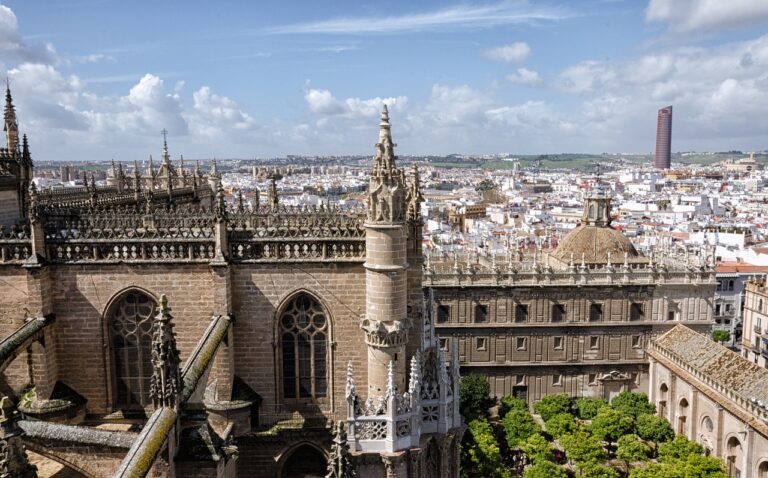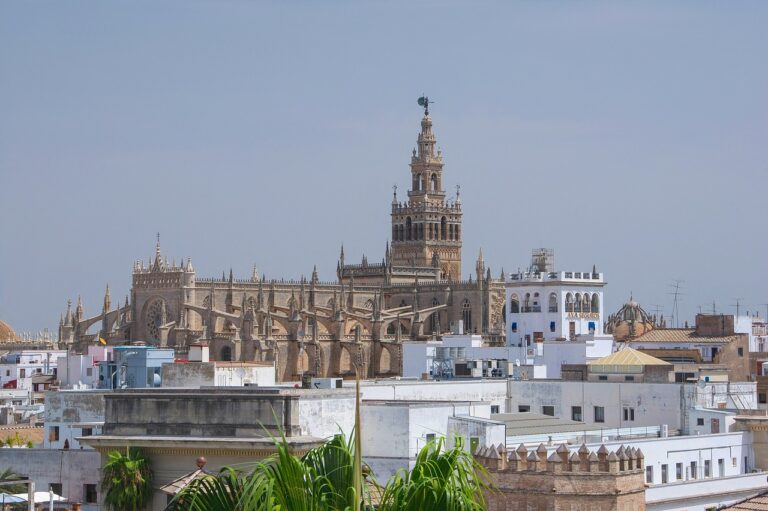Exploring the Sevilla Catedral
Exploring the Sevilla Catedral
Sevilla, the capital of Spain’s Andalusia region, is a city rich in history and culture. One of its most iconic landmarks is the Sevilla Catedral, also known as the Cathedral of Saint Mary of the See. As the largest Gothic cathedral in the world and a UNESCO World Heritage site, the Sevilla Catedral is a must-visit for anyone exploring the city. In this blog post, we’ll take a closer look at the history, architecture, and key features of this magnificent building.
Origins and Construction of the Sevilla Catedral
The Sevilla Catedral was built on the site of a former mosque, reflecting the city’s diverse cultural heritage. After the Christian reconquest of Sevilla in 1248, the mosque was used as a church. However, by the late 14th century, the decision was made to construct a grand cathedral that would demonstrate the wealth and power of the city
Construction of the Sevilla Catedral began in 1401 and took over a century to complete, with the main structure finished in 1506. The cathedral was designed in the Gothic style, which was popular in Europe during that time. Over the centuries, additional elements in Renaissance and Baroque styles were added, giving the cathedral its unique architectural character.
The Sevilla Catedral was built to symbolize the city’s importance and to honor the Christian faith. It was intended to be “so grand that those who see it finished will think we were mad,” according to the city’s leaders at the time. The result is a breathtaking structure that continues to awe visitors today.
Architectural Highlights of the Sevilla Catedral
One of the most distinctive features of the Sevilla Catedral is the Giralda, its bell tower. Originally built as a minaret for the mosque in the 12th century, the Giralda was converted into a bell tower after the reconquest. The tower stands 104 meters (341 feet) tall and offers spectacular views of the city. Visitors can climb to the top via a series of ramps, which were designed to allow riders on horseback to ascend easily.
The Nave and Vaults
The interior of the Sevilla Catedral is equally impressive. The nave, or central hall, is one of the longest in the world, measuring 42 meters (138 feet) high. The vaulted ceilings, supported by massive columns, create a sense of awe and grandeur. The sheer size of the nave allows for abundant natural light to filter in through the stained glass windows, illuminating the intricate details of the architecture.
The Main Chapel
The Capilla Mayor, or Main Chapel, is the heart of the Sevilla Catedral. It houses the largest and most elaborate altarpiece in the world, a masterpiece of Gothic art. The altarpiece, known as the Retablo Mayor, depicts scenes from the life of Christ and the Virgin Mary. It was crafted over several decades by a team of artists and is a stunning example of medieval craftsmanship.

Key Features and Attractions of the Sevilla Catedral
Christopher Columbus’s Tomb
One of the most significant and visited parts of the Sevilla Catedral is the tomb of Christopher Columbus. The explorer’s remains were moved several times after his death, and today they rest in an elaborate monument inside the cathedral. The tomb is supported by four statues representing the kingdoms of Castile, León, Aragón, and Navarra. It is a powerful tribute to Columbus’s role in the Age of Exploration.
The Sacristy and Treasury
The Sacristy and Treasury of the Sevilla Catedral house an impressive collection of religious artifacts, including gold and silver chalices, intricately embroidered vestments, and other precious items. Among the treasures is the “Custodia de Arfe,” a massive silver monstrance used in religious processions. The intricacy and beauty of these items offer a glimpse into the cathedral’s rich history and the artistic talents of the time.
The Patio de los Naranjos
The Patio de los Naranjos, or Courtyard of the Orange Trees, is another remnant of the mosque that once stood on the site. This peaceful courtyard is filled with fragrant orange trees and features a central fountain. It serves as a lovely place to rest and reflect during a visit to the cathedral. The courtyard’s layout and design are reminiscent of Islamic architecture, highlighting the blend of cultural influences in Sevilla.
The Chapter House
The Chapter House, or Sala Capitular, is an exquisite example of Renaissance architecture within the Sevilla Catedral. It is an oval-shaped room with a beautifully painted dome ceiling and richly decorated walls. The Chapter House was used for important meetings and ceremonies by the cathedral’s clergy. Today, it is a testament to the artistic and architectural achievements of the Renaissance period.
Visiting the Sevilla Catedral
Opening Hours and Tickets
The Sevilla Catedral is open to visitors throughout the year, with varying hours depending on the season. It is advisable to check the official website for the most up-to-date information on opening times and ticket prices. Tickets can be purchased at the entrance or online in advance, which can help avoid long lines.
Guided Tours
For a deeper understanding of the cathedral’s history and significance, consider joining a guided tour. Knowledgeable guides can provide fascinating insights and stories about the cathedral’s construction, its role in Sevilla’s history, and the various artworks and relics housed within. Audio guides are also available for those who prefer to explore at their own pace.

Tips for Visitors
Dress Code: As the Sevilla Catedral is a place of worship, modest clothing is required. Shoulders and knees should be covered.
Photography: Photography is allowed inside the cathedral, but be mindful of other visitors and avoid using flash.
Timing: To avoid crowds, try to visit early in the morning or later in the afternoon. Weekdays are generally less busy than weekends.
Climbing the Giralda: The climb to the top of the Giralda is not particularly strenuous, but it involves several ramps. Comfortable shoes are recommended.
Conclusion
The Sevilla Catedral is more than just a building; it is a testament to the city’s rich history, cultural diversity, and artistic heritage. From its awe-inspiring Gothic architecture to the treasures it holds within, the cathedral offers a unique and unforgettable experience for visitors. Whether you are a history buff, an art enthusiast, or simply a curious traveler, exploring the Sevilla Catedral is sure to be a highlight of your visit to this beautiful city. So, take your time, soak in the beauty, and let the history of Sevilla unfold before your eyes.
